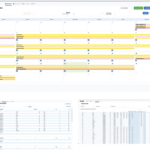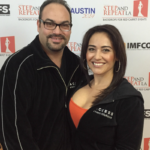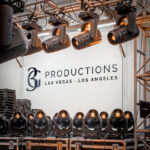The Atlanta-Area Hub is Setting the Stage for Future Growth in the U.S., Canada and Latin America
Kinesys, co-founded in 2003 by U.K. managing director (and Kinesys USA CEO) Dave Weatherhead, started as so many of the innovations that have pushed this industry forward with a simple request, “Can you make this?”
“I reckon so,” was the response Weatherhead gave the production manager who wanted a chain hoist controller with variable speed for an upcoming tour. Working on his own at home, the story goes, he sat down to write the software, cobbled together a variable frequency drive and mated it to a motor. A mere six weeks later, he delivered the prototype, which not only worked but proved reliable as well. It became the basic design for all future Kinesys systems.
Weatherhead had previously worked for an industry leading rigging company with the automated elements for everything from stunts in blockbuster Hollywood films to car launches for the world’s press and touring concerts for various music artists.
During the development of the prototype, he realized a gap existed in the market for premium quality automation products backed up with exceptional service.
Andy Cave, one of the original directors of Kinesys, had an extensive lighting background. It was the meeting of the minds of these two disciplines, which determined the architecture in terms of cabling and communications. The comparative similarities practically mirror that of a DMX-controllable lighting console and an intelligent lighting fixture, which make the Kinesys product line easy for people to wrap their heads around.
“Our cabling and packaging are more like off the shelf lighting system components,” says David Bond, head of sales for Kinesys North America. “Rather than a custom system that is different for each application, our systems are straightforward and standardized. I believe that is part of what Kinesys does better than most of the other variable speed automation systems out there.”
During the ensuing years, Kinesys became a global presence with sales and rental offices worldwide. Their corporate facility in the U.K. has remained the sole distributorship. In 2015, the company opened a sales office in Lithia Springs, GA. David Bond; Head of Sales for North America is currently in the processes of gearing up staff to receive the influx of Apex inventory due to arrive in July.
Originally, from England, his career began his in Canada, which includes an extensive background in touring production management. Bond returned to the U.K. for 10 years, worked on various arena touring projects and spent five years deeply involved in the management of Star Rigging as well.
“Along with touring and rentals,” says Bond, “Star Rigging managed venue contracts in Wembley, Manchester Arena and the Millennium Stadium in which a Kinesys system had been installed. As such, operation and maintenance of their system came under my remit.”
He later returned to Canada, where he started a boutique rigging company selling rescue kits, load cells and offering Kinesys as part of his line.
“Kinesys sales took off so well that the company offered me a permanent position. I was ecstatic and immediately accepted their offer,” Bond says.
Location, Location, Location
The facility in Georgia is the right balance of location, price and ceiling height, according to Bond.
“Obviously if we are going to be flying stuff, we need a little height,” he says. “Typically, that comes with a massive warehouse, which we do not need. We actually have more space than we currently need but we chose a place to grow into, not out of.”
A straight shot up the road, just 15 miles away, is Hartsfield International Airport, with hotels and restaurants within walking distance.
The facility has a dedicated training classroom as well as an area for demoing equipment, which is used by the trainees for practical sessions as well as by staff for testing products and new concepts.
“We hold training classes at the facility,” says Bond. With a system purchase, “we bring the customer in for a two-day training session. They may bring additional techs or shop staff that needs education during that time. The classroom sessions teach clients the concepts of our systems as well as how our software works”
Martin Honeywill, a director at Kinesys, is a designer and the chief systems trainer. Based in the U.K., he will travel to Atlanta for such sessions.
“Martin has extensive experience in the field and on movie sets. He knows what it is like to be operating in real time under the pressure of a director demanding results. It is one of the reasons he is such a great trainer,” Bond notes. “His teaching is industry-based because these are not adapted industrial kits. From the ground up, they are made for the purpose of entertainment automation.”
The Atlanta facility offers ad hoc training sessions, during their open house events. “We also welcome people from the lighting and video sectors who want to become familiar with our systems,” says Bond. “And we can provide sessions tailored to technicians operating our systems on the road much like, say grandMA classes.”
Vector and K2
Completing the parallel of Kinesys systems functioning on a lighting level are the software protocols for control and programming. Vector, their most popular software, runs on compatible Windows computers to control and run Kinesys motion control products.
The versatile application has a wealth of cue creation and editing features designed to allow rapid entry and programming of cues. It can also run rotational as well as linear automation simultaneously, all from one screen.
The spreadsheet lays out and reads like a lighting desk monitor. Hoists get assigned channels, acceleration and deceleration times and time for overall progress of cue. The internal software also takes into account the various position, speed and characteristics of each motor to calculate proper execution of these parameters so execution and timing are uniform; exactly like programming a moving light fixture.
The Kinesys K2 controller is also a Windows based platform, but a much more sophisticated system, offering a 3D Visualizer to see movement in real space. There is also an optional console version for K2.
Since the software operates in a virtual world, the system can also predict if objects will collide. The program will talk to other previz systems, allowing pre-programming of automation in conjunction with intelligent lighting.
Once programmed, the file then becomes a real world operation, calculating and sending information to the hoists how to execute the cue.
Moving Lights and Structures
“K2 and Vector can output our positional data to grandMA and numerous brands of media servers, which integrate that information to update intelligent lighting fixtures positions, projection mapping and content mapping,” says Bond.
Variable speed systems are not just a creative tool but can negate the potential damage to loads or supporting structures simply by slowing down the move before it actually stops. This has many advantages, but becomes particularly handy when moving huge video walls. Programming a slower deceleration before full stop or acceleration before trim eliminates the “bounce” due to dynamic shock load.
What’s In Store
Kinesys USA’s CEO Dave Weatherhead says, “We have had a very positive response to Kinesys putting down roots in the U.S.. David Bond’s approachable style and extensive knowledge of rigging standards makes him the perfect ambassador for Kinesys in North America.
Kinesys and its robust, reliable, highly flexible and user-friendly products have surged in popularity in the U.S. over the last two years, and the move is part of the company’s planned medium term expansion strategy to optimize sales, technical sup]port and after-sales service for all Kinesys owners and users — existing and potential.
It also sends a strong message that the industry-leading brand is very serious about consolidating the level of support for its U.S. clients and enhancing its presence in the Americas. Kinesys U.S. will also be a commercial hub for business in Canada, Central and South America.

Kinesys Launches Apex System at PL+S 2017
With the launch of their latest variable speed chain hoist system at Prolight+Sound 2017, technology company Kinesys once again holds true to their company philosophy, “Progress is never stationary.”
Designated “Apex,” the very name itself speaks to the culmination of over 15 years of specializing in the design, manufacture and installation of motion control systems for the entertainment industry.
Since its inception, Kinesys has offered variable speed conversions of the most popular hoist brands on the market, which replaced the electronics, while leaving the brakes and gearbox intact.

While this is still a core component of their manufacturing line, the Apex system is a completely new variable speed chain hoist built for Kinesys by Liftket solely to meet Kinesys specifications and carries Kinesys brand name.
The 1/2-ton (500kg) hoist can travel at speeds up to 100 fpm. The Apex system has two main components, the drive and the hoist. E-Stop and data management for the system is handled by the Mentor E-Stop aggregator and data distribution unit, which can manage up to 100 Apex hoists. Apex is compatible with the existing Kinesys motion control software platforms of Vector and K2.
The Apex hoist is extremely quiet. The brakes are silent and individually monitored and Apex has the ability to provide full torque while “in situ” or “hovering”. The brakes disengage and the magnetic field created by the coil holds the weight. This means for every start, stop and redirection, the mechanical noise is virtually inaudible.
Just like the readout display of an intelligent lighting fixture, which retains length of use, bulb hours and other fixture information, the apexDrive has the intelligence to monitor and log its own work history and predict performance capacity by recording the run-time, speed and load it has handled. Most importantly, real time feedback is available at the controller.
There are several key differences to the existing Kinesys elevation1+ variable speed system. The elevation1+ is interchangeable with most popular hoist brands on the market, provided Kinesys have converted the machine. Usually the personality of the motor, which the drive is attached to, has to be entered in the Vector or K2 software for programming purposes. With Apex, only the 0.5Ton and 1.25Ton Apex motors are compatible yet the motor “tells” the apexDrive what it is when it is plugged in, negating the need to select profiles. The multi-function Harting-style cable connector between the drive and hoist is the only proprietary piece of cabling in the system. It carries 3-phase power, all data connections, limit sensing and control. Powering an Apex system is achieved by means of common Ceeform or Twistlock cables and Ethernet data distribution. Both can be daisy-chained and no specialist power distribution is required making it more flexible and cost effective.
All control components meet Safety Integrity Level 3 (SIL3) including redundant controller processing, encoders and E-Stop system.
Replacing the integrated load cell, a simple procedure the end-user can carry out and does not require motor recertification.

Company Snapshot: Kinesys
- When Founded: 2003
- U.S. Division Founded: 2014
- Headed By: Dave Weatherhead, Managing Director, Kinesys; and CEO, Kinesys USA; David Bond, head of sales for Kinesys North America.
- Locations: London, U.K.; Lithia Springs (Atlanta Area), GA.
- Product Lines: Automation systems and devices including Apex (high-end chain hoist control applications), Libra (load monitoring devices), DigiHoist (fixed speed digital control system for chain hoists), Elevation (truss mounting variable speed chain hoist control solution and Velocity 2 (works with Kinesys’ Velocity 2 Drive, a variable speed controller).
- More Info: KinesysUSA.com, www.Kinesys.co.uk


